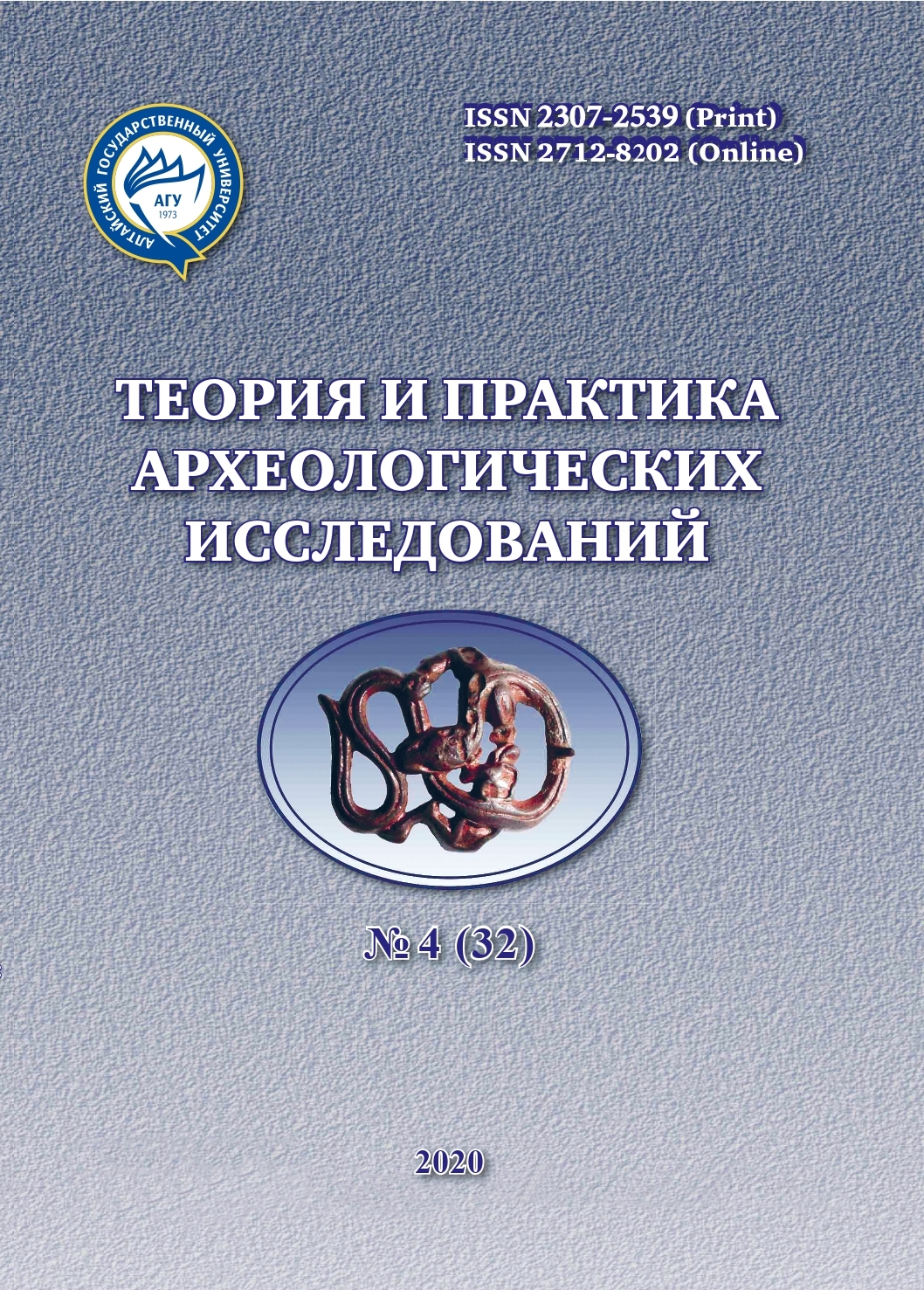THE FINDS FROM THE DESTROYED BURIAL OF THE PAZYRYK CULTURE IN THE BARAGASH VILLAGE (the Altai Republic)
Abstract
The paper presents the results of the study of finds originating from the destroyed burial in the village of Baragash (the Shebalino district, the Altai Republic), located in the upper reaches of the Peschanaya river. The burial was destroyed in 2015 during the digging of a trench for the water supply, which passed approximately through the center of the burial mound. During the inspection of the mound, the employees of the Agency for Cultural and Historical Heritage of the Altai Republic collected details of horse equipment, jewelry, household items and weapons. The burial contained bone arrowheads, a bead, plaques made of gold foil, bronze clips, a painted ceramic vessel, a whetstone, and a horn cheekpiece. Fragmentary information about the structural features of the destroyed object, as well as the analysis of items allows us to establish that the complex belongs to the Pazyryk culture of the Scythian time of Altai. The horn cheekpiece found in the burial, decorated with the heads of a wolf and a bird of prey, as well as bronze clips, make it possible to establish the attributing of the object to an early group of Pazyryk sites. The absolute dating of the complex can be tentatively established by the end of the 6th – 5th centuries BC.
Downloads
Metrics
No metrics found.
References
Dashkovskij P.K. Issledovanie kurgana rannego etapa pazyrykskoj kul’tury na mogil’nike Hankarinskij Dol v Severo-Zapadnom Altae: hronologiya i atribuciya artefaktov [The Study of a Burial Mound of the Early Stage of the Pazyryk Culture at the Khankarinsky Dol Burial Ground in Northwestern Altai: Chronology and Attribution of Artifacts]. Arheologiya, etnografiya i antropologiya Evrazii [Archaeology, Ethnography and Anthropology of Eurasia]. 2020. Vol. 48. №1. Pp. 91–100 DOI: 10.17746/1563-0102.2020.48.1.091-100.
Kireev S.M., Shul’ga P.I. Sbrujnye nabory iz Ujmonskoj doliny [Harness Sets from the Uimon Valley]. Izuchenie istoriko-kul’turnogo naslediya narodov Yuzhnoj Sibiri [Study of the Historical and Cultural Heritage of the Peoples of Southern Siberia]. Gorno-Altajsk : AKIN, 2006. Issue 3–4. Pp. 90–107.
Kiryushin Yu.F., Stepanova N.F. Skifskaya epoha Gornogo Altaya. Chast’ III: Pogrebal’nye kompleksy skifskogo vremeni Srednej Katuni [Scythian Era of Mountainous Altai. Part III: Burial Complexes of the Scythian Time of the Middle Katun]. Barnaul : Izd-vo Alt. un-ta, 2004. 292 p.
Kiryushin Yu.F., Stepanova N.F., Tishkin A.A. Skifskaya epoha Gornogo Altaya. Chast’ II: Pogrebal’no-pominal’nye kompleksy pazyrykskoj kul’tury [Scythian Era of Altai. Part III: Burial Complexes of the Scythian Time of the Middle Katun]. Barnaul : Izd-vo Alt. un-ta, 2003. 234 p.
Korol’kova E.F. Zverinyj stil’ Evrazii. Iskusstvo plemen Nizhnego Povolzh’ya i Yuzhnogo Priural’ya v skifskuyu epohu (VII–IV vv. do n.e.). Problemy stilya i etnokul’turnoj prinadlezhnosti [The Animal Style of Eurasia. The Art of the Tribes of the Lower Volga and Southern Urals in the Scythian era (the 7th – 4th Centuries BC). Style and Ethnocultural Issues]. SPb. : Peterburgskoe Vostokovedenie, 2006. 272 p.
Kubarev V.D. Drevnetyurkskie izvayaniya Altaya [Ancient Turkic Sculptures of Altai]. Novosibirsk : Nauka, 1984. 230 p.
Kubarev V.D. Kurgany Sajlyugema [Mounds of Saylyugem]. Novosibirsk : Nauka, 1992. 220 p.
Kubarev V.D. Raspisnye sosudy iz kurganov Altaya [Painted Vessels from the Altai Mounds]. Problemy izucheniya drevnej i srednevekovoj istorii Gornogo Altaya [Problems of Studying the Ancient and Medieval History of the Altai Mountains]. Gorno-Altajsk : GANIIYaL, 1990. Pp. 31–35.
Kubarev V.D., Matochkin E.P. Petroglify Altaya [Petroglyphs of Altai]. Novosibirsk : Izd-vo In-ta arheologii i etnografii SO RAN, 1992. 123 p.
Kubarev V.D., Slyusarenko I.Yu. Raspisnye sosudy kurganov urochishche Bike [Painted Vessels of the Bike Tract Burial Mounds]. Arheologicheskie issledovaniya na Katuni [Archaeological Research on the Katun]. Novosibirsk : Nauka, 1990. Pp. 185–192.
Kubarev V.D., Shul’ga P.I. Pazyrykskaya kul’tura (kurgany Chui i Ursula) [Pazyryk Culture (mounds of Chuya and Ursula)]. Barnaul : Izd-vo Alt. un-ta, 2007. 282 p.
Mamadakov Yu.T. Sosudy s rospis’yu s mogil’nika Kyrlyk-II [Vessels with Painting from the Kyrlyk-II Burial Ground]. Itogi izucheniya skifskoj epohi Altaya i sopredel’nyh territorij [Results of the Study of the Scythian Era of Altai and Adjacent Territories]. Barnaul : Izd-vo Alt. un-ta, 1999. Pp. 101–104.
Mogil’nikov V.A., Elin V.N. Kurgany Taldura-I [Mounds of Taldur-I]. KSIA [Mounds of Taldur-I]. M. : Nauka, 1982. Issue 170. Pp. 103–109.
Potapov L.P. Ocherki po istorii altajcev [Essays on the History of the Altaians]. M.; L. : Nauka, 1953. 444 p.
Rudenko S.I. Gornoaltajskie nahodki i skify [Gorno-Altai Finds and Scythians]. M.; L. : AN SSSR, 1952. 268 p.
Soenov V.I., Trifanova S.V., Konstantinov N.A., Soenov D.V., Shtanakova E.A., Ebel’ A.V. Arheologicheskie pamyatniki verhov’ev r. Peschanoj [Archaeological Sites of the Upper Part of the Peschanaya River]. Drevnosti Sibiri i Central’noj Azii [Antiquities of Siberia and Central Asia]. Gorno-Altajsk : GAGU, 2012. №4 (16). Pp. 27–69.
Soеnov V.I., Ojnoshev V.P. Arheologicheskie pamyatniki i ob”ekty Shebalinskogo rajona [Archaeological Sites and Objects of the Shebalinsky Region]. Gorno-Altajsk : AKIN, 2006. 100 p.
Sorokin S.S. Cepochka kurganov vremen rannih kochevnikov na pravom beregu r. Kok-Su (Yuzhnyj Altaj) [A Chain of Mounds from the Time of the Early Nomads on the Right Bank of the Kok-Su River (Southern Altai)]. ASGE. Issue 16. L. : Avrora, 1974. Pp. 16–91.
Hudyakov Yu.S., Belinskaya K.Y. Kamennoe izvayanie iz urochishcha Ajlyan v Gornom Altae [A Stone Statue from the Ailyan Tract in the Altai Mountains]. Arheologiya, etnografiya i antropologiya Evrazii [Archaeology, Ethnography and Anthropology of Eurasia]. 2012. №1 (49). Pp. 122–130.
Shul’ga P.I. Skotovody Gornogo Altaya v skifskoe vremya (po materialam poselenij) [Cattle Breeders of the Altai Mountains in the Scythian Time (based on materials from settlements)]. Novosibirsk : RIC NGU, 2015a. 336 p.
Shul’ga P.I. Snaryazhenie verhovoj loshadi v Gornom Altae i Verhnem Priob’e: v 2 ch. Ch. II (VI–III vv. do n.e.) [Riding Horse Equipment in the Altai Mountains and the Upper Ob Region: in 2 Parts. Part II (the 6th – 3rd Centuries BC)]. Novosibirsk : RIC NGU, 2015b. 322 p.
Theory and Practice of Archaeological Research is a golden publisher, as we allow self-archiving, but most importantly we are fully transparent about your rights.
Authors may present and discuss their findings ahead of publication: at biological or scientific conferences, on preprint servers, in public databases, and in blogs, wikis, tweets, and other informal communication channels.
Theory and Practice of Archaeological Research allows authors to deposit manuscripts (currently under review or those for intended submission to ABS) in non-commercial, pre-print servers such as ArXiv.
Authors who publish with this journal agree to the following terms:
- Authors retain copyright and grant the journal right of first publication with the work simultaneously licensed under a Creative Commons Attribution License (CC BY 4.0) that allows others to share the work with an acknowledgement of the work's authorship and initial publication in this journal.
- Authors are able to enter into separate, additional contractual arrangements for the non-exclusive distribution of the journal's published version of the work (e.g., post it to an institutional repository or publish it in a book), with an acknowledgement of its initial publication in this journal.
- Authors are permitted and encouraged to post their work online (e.g., in institutional repositories or on their website) prior to and during the submission process, as it can lead to productive exchanges, as well as earlier and greater citation of published work (See The Effect of Open Access).








2.jpg)




